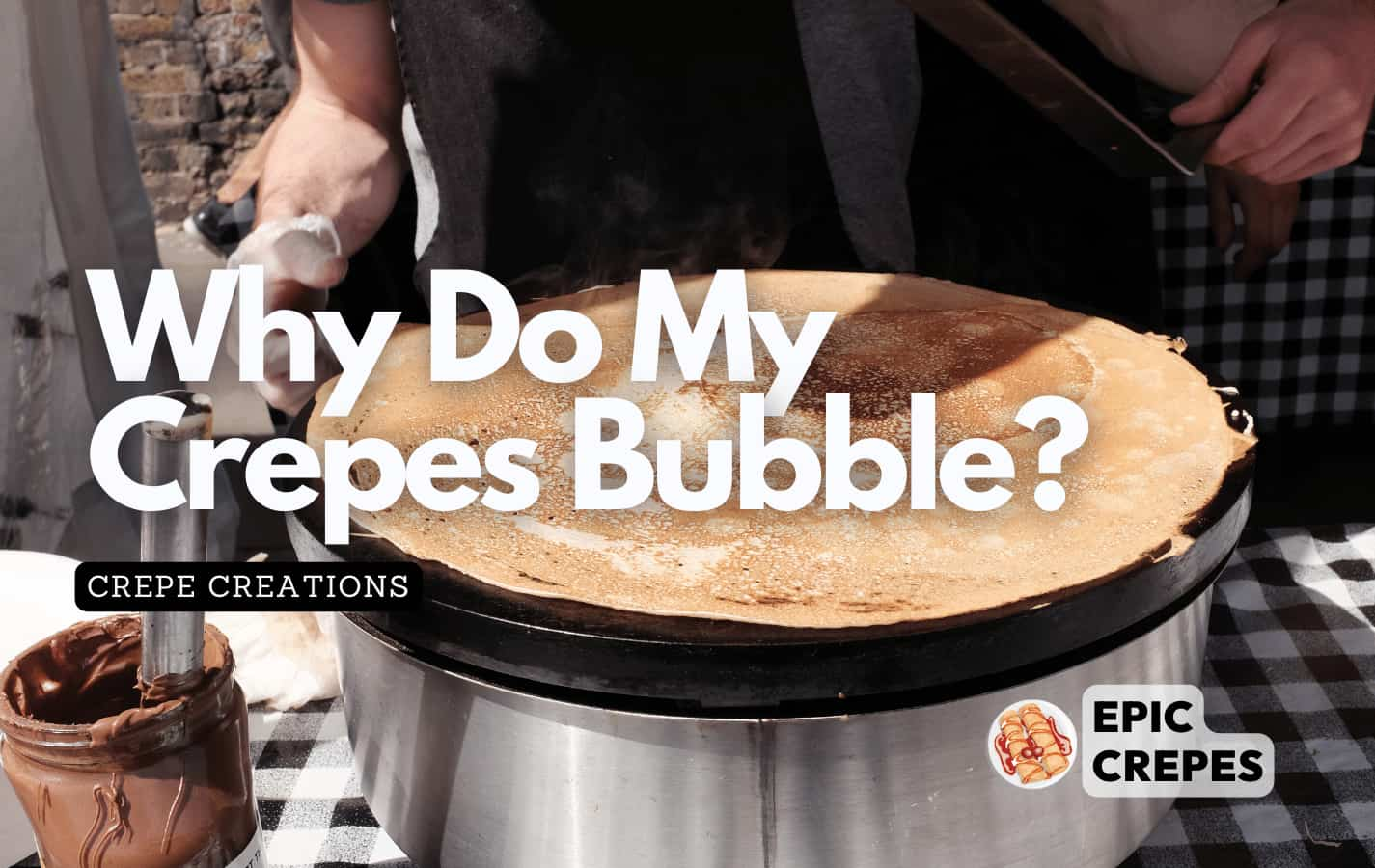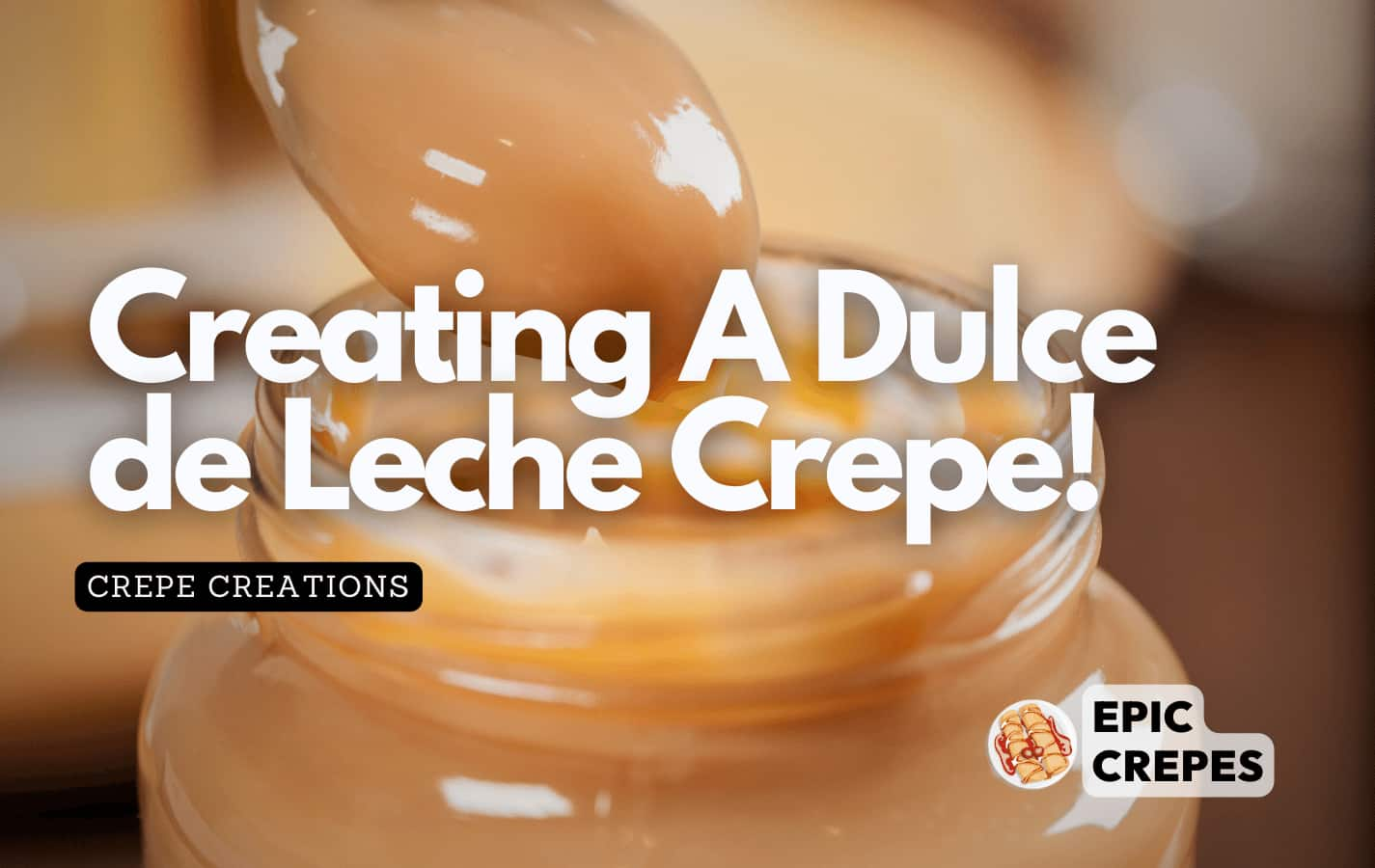Have you ever tried to make crepes, only to find that they come out with unsightly bubbles on the surface? Don’t worry, you’re not alone. Many people struggle with this issue, but it can be frustrating when you’re trying to create a perfect dish.
There are a few reasons why your crepes may have bubbles, and understanding them can help you achieve the smooth, professional look that you’re going for.
One reason for bubbly crepes is that the batter may be too thick. When the batter is too thick, it doesn’t spread evenly across the pan, which can lead to air pockets forming underneath the surface.
Another possible cause of bubbles is that the pan may not be hot enough when you add the batter. If the pan isn’t hot enough, the batter will take longer to cook and will begin to form bubbles before it has fully set.
These are just a couple of factors that could be contributing to your bubble problem – keep reading to learn more about how to fix it!
Understanding The Causes Of Bubbly Crepes
Crepes are a delicious breakfast food that can be made in many different ways. However, if you’ve noticed bubbles forming on your crepes, it’s important to understand why this is happening.
One potential cause of bubbly crepes is over mixing the batter. When crepe batter is over mixed, it can become too aerated and create bubbles as it cooks.
Another factor to consider when making crepes is the type of flour you use. Different types of flour have different properties and can affect the texture and consistency of your batter. If you use a flour with high protein content, such as bread flour, this can lead to more gluten development in your batter which can create bubbles during cooking.
To avoid bubbly crepes, it’s important to pay attention to the texture of your batter when mixing. Avoid over mixing and aim for a smooth consistency without any lumps. Additionally, consider experimenting with different types of flour to find one that works best for your desired texture.
Adjusting The Thickness Of Your Crepe Batter
Like a painter with their brush, the consistency of your crepe batter can greatly affect the outcome of your culinary masterpiece.
If your batter is too thick, it will not spread evenly on your pan and leave behind unsightly bubbles. This is a common issue that many novice crepe makers face, but fear not, for there is a simple solution.
Thinning out your batter may be just what you need to achieve the perfect crepes. To do this, simply add a bit more liquid (such as milk or water) until the batter reaches a thinner consistency.
The ideal consistency should resemble that of heavy cream – thin enough to easily spread across your pan without leaving bubbles behind.
By adjusting the thickness of your batter, you can ensure that each crepe cooks evenly and comes out perfectly every time. However, this is only one step in perfecting your crepe-making skills.
The next crucial step is ensuring proper heat in your crepe pan so that each crepe cooks evenly and to perfection.
Ensuring Proper Heat In Your Crepe Pan
To ensure that your crepes do not have bubbles, it is crucial to maintain the right heat in your crepe pan. Using the right oil is also essential to prevent your crepes from sticking to the pan.
Firstly, make sure that your pan is heated evenly and at the right temperature before pouring the batter. This can be done by heating the pan for a few minutes on medium-high heat with a small amount of oil, then wiping off any excess oil with a paper towel.
Secondly, use flipping techniques such as gently lifting and flipping the crepe with a spatula or tossing it in the air using a flicking motion of your wrist.
Practice these techniques until you find what works best for you and stick with it.
Remember, following these tips will help you achieve perfectly cooked crepes without any bubbles or sticking. For more tips and tricks, keep reading!
Other Tips And Tricks For Perfect Crepes
Making the perfect crepes is an art that requires patience and skill. It’s like painting a canvas, where every stroke must be careful and precise to achieve a masterpiece.
But even with experience, sometimes bubbles can appear on the crepe’s surface. This issue may arise from using too much batter or cooking at a high temperature. However, don’t worry; there are tips and tricks you can use to avoid this problem.
One of the best ways to prevent bubbles from forming on your crepes is by using the correct amount of batter. Too much batter will result in thick crepes, which will take longer to cook and produce bubbles. On the other hand, too little batter may cause uneven cooking and tear easily when flipping. Therefore, you should measure your ingredients accurately and use just enough batter for each crepe.
Flipping techniques also play a significant role in making perfect crepes. Many people struggle with flipping their crepes without breaking them or causing them to fold over themselves. The key is to loosen the edges gently with a spatula before flipping it over in one swift motion using your wrist’s flicking action. Practice makes perfect, so keep trying until you master this technique. Once you get it right, you’ll be able to create beautiful golden-brown crepes every time.
When it comes to fillings, the possibilities are endless! From sweet options like Nutella and berries to savory ones such as ham and cheese or spinach and feta – choosing the best fillings for your preference is crucial in creating delicious crepes. Remember always to spread them thinly across the surface of your cooked crepe before folding it over for optimal enjoyment.
Making perfect crepes requires trial and error; however, by following these tips and tricks for measuring batter correctly, mastering flipping techniques, and selecting great filling options – you’ll be ready to whip up gourmet-style crepes in no time!
Frequently Asked Questions
What Are Some Common Fillings For Crepes?
When it comes to crepes, there are endless possibilities for fillings.
Some popular sweet options include Nutella and banana, berries and cream, or simply powdered sugar and lemon juice.
On the savory side, options range from traditional ham and cheese to modern twists like spinach and feta or mushroom and goat cheese.
Whether you prefer sweet or savory, traditional or modern flavors, the beauty of crepes is their versatility in accommodating a wide range of fillings.
How Do I Store Leftover Crepes?
Leftover crepes are like little treasures waiting to be rediscovered.
Freezing them is an easy way to make sure they’re always on hand for a quick and delicious meal.
When reheating crepes, it’s best to gently warm them in the microwave or on the stovetop, being careful not to overcook and dry them out.
With just a little bit of effort, you can enjoy the fluffy goodness of your homemade crepes any time you want!
Can I Make Crepes Without A Crepe Pan?
Looking to make crepes without a crepe pan?
Fortunately, there are alternative cooking methods available that don’t require one. However, keep in mind that the consistency of your batter may need to be adjusted for the chosen method.
Troubleshooting batter consistency is important to ensure your crepes cook evenly and come out just right. Don’t let the absence of a crepe pan discourage you from making this delicious dish – experiment with different cooking methods and find what works best for you!
What Is The Difference Between Crepes And Pancakes?
Crepes and pancakes are two beloved breakfast foods that share some similarities but have distinct differences.
Crepes are thin, while pancakes tend to be thick and fluffy. Crepes can be sweet or savory, while pancakes are typically sweet.
The history and origins of crepes date back to the 12th century in Brittany, France, where they were traditionally made with buckwheat flour and served with savory fillings like ham and cheese.
Pancakes, on the other hand, have been a staple breakfast food in America since the 18th century.
Despite their differences, both crepes and pancakes make for a delicious breakfast treat that can be enjoyed in many ways.
How Many Crepes Should I Expect To Make With One Batch Of Batter?
Hey there! Let’s talk about how many crepes you can expect to make with one batch of batter.
Generally, a standard batch of crepe batter will yield around 12-15 crepes, depending on the size of your pan and how thin you like them. However, if you’re making mini crepes or using a larger pan, you may end up with more or less.
As for tips and variations, try adding different flavorings to your batter such as vanilla extract or cinnamon for an extra kick. And don’t forget to let your batter rest before cooking – this will help prevent bubbles from forming in your crepes.
Happy cooking!
Conclusion
So if you’ve ever made crepes before, you may have noticed bubbles forming on the surface of your crepe. Don’t worry, this is a common occurrence and doesn’t mean that your crepes are ruined. In fact, it’s a sign that the batter is doing what it’s supposed to do.
When making crepes, it’s important to use a thin batter and cook them over low heat. If the heat is too high or the batter is too thick, bubbles can form on the surface as steam escapes from the batter.
But with patience and practice, you’ll be able to make perfect crepes every time! As they say, practice makes perfect.
In conclusion, don’t let a few bubbles in your crepes discourage you from making them again. With some tips and tricks (and a little bit of patience), you’ll be able to master this French delicacy in no time.
So go ahead and experiment with different fillings, store any leftovers properly, and don’t be afraid to try making them without a crepe pan.
Bon appétit!




